Much of what happened during the pandemic was problematic, but challenging times led to positive emergences like virtual appointments.
And in no category did virtual appointments play a more important role than in the home category. With the work-from-home population likely to be a mainstay in our society, our needs for our homes will continue to grow and evolve.
While I tested out virtual appointments on a few of the home sites during the height of the pandemic, I thought the launch of our 2022 Home Goods report would be an excellent time to see what was new and how retailers were performing in this post-pandemic world.
I started my journey looking at the Digital Commerce 360 Top 1000 database. My selection criteria for this mini research study included being able to conduct a virtual appointment. Those that would strictly allow just a phone call were not included as part of my onsite review or appointment outreach. Additionally, services had to be available nationally rather than on a more limited, regional basis.
Online shoppers start to express interest
A quick look at some of the related findings from our Digital Commerce 360 and Bizrate Insights 2022 home goods survey of 1,113 online shoppers provides additional perspective on this topic. This is a category where we often see cross-channel behavior. 23% of survey respondents indicated they had visited a physical store in advance of placing an order online. Tangentially, 9% took advantage of 3D planners and 7% of the design services that retailers made available to help select products. While just 6% suggested virtual appointments are important when shopping for everything home-related online, I believe this will continue to grow, as these services are in their infancy. Positively, 7% of those surveyed said they already took advantage of such design services. Among participants, booking appointments online for the following services ranged from in-home services (9%), in-store (5%) and virtual (4%).
While many of the retailers discussed are national specialty retailers, Interior Define offers services comparable to that of larger companies. Interior Define clearly lays out the options for its customers. It begins with visiting a Define Studio while also introducing free design services available by appointment or via chat. They offer the Web AR tools and will let shoppers order up to 10 free swatches, touching on many of our survey issues.
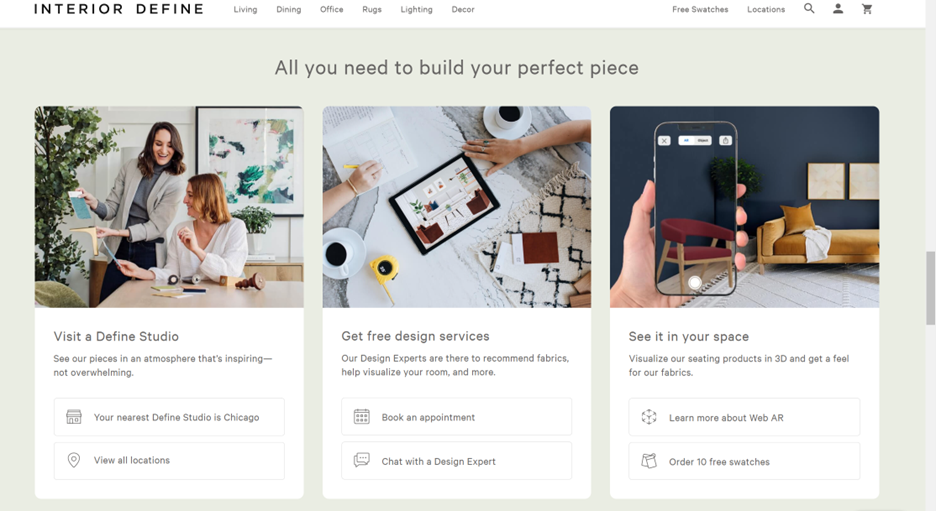
Design services highlighted to drive purchasing
Ultimately, seven retailers and their design services were selected for comparison purposes. At first glance, most appeared to be free, though Restoration Hardware called out that it was complimentary for members. I was unclear, though, when inquiring via my appointment email. They clarified that there would be no cost.
Appointments range from virtual to in-store for all of these companies. While virtual services are certainly convenient and served as a means for survival during the pandemic, I would have to believe that getting shoppers to visit the store results in a greater upside. There, they can quickly walk the floor and get a sense of all the options while also gaining more confidence about their choices.
Three including La-Z-Boy, Pottery Barn and West Elm also extended an option to come to one’s home to provide these services. Pottery Barn and West Elm are under Williams-Sonoma, which ranks No. 22 in our Top 1000. La-Z-Boy ranks No. 258. As seen in the Pottery Barn example below, they identify the perks of each option. I gravitate to the in-home design appointment, as the associate does all the work and is in the best position to assess style and needs. Ironically, now that I have done a few, I would likely opt to always start virtually and combine with an in-store visit.
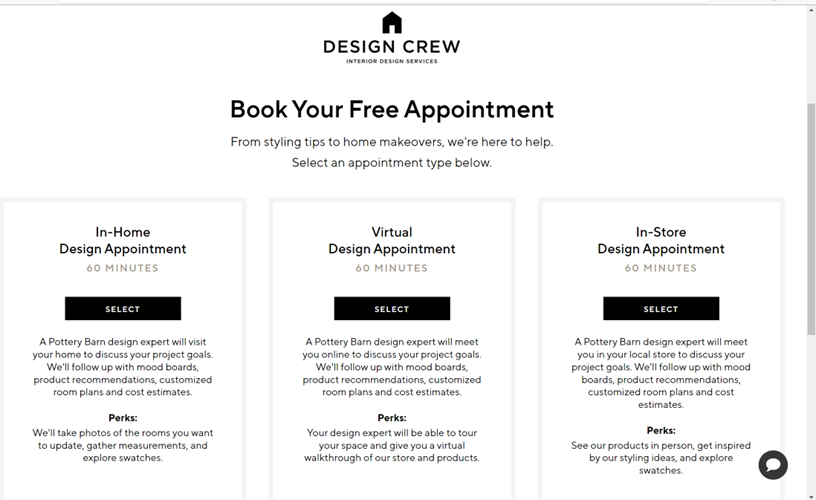
Based on an initial look at available services, the universal presence in navigation and dedicated real estate spoke to their value for each of these companies. It’s important to remember that merchandising is fluid, as new tactics are constantly introduced, lacking a permanent presence. Three (Restoration Hardware, Pottery Barn and West Elm) also have a chat call out specifically focused on design.
Based on the pop-up from Room and Board, my sense is that getting shoppers to seek advice and make an appointment is core to their business model. One can only assume this shopper is simply more invested.

As another point of reference, since I have been working on this project, both West Elm and Pottery Barn (part of the Williams-Sonoma family of brands) invited me via email to take advantage of their design services. After providing the “what, where and when” details, West Elm reinforces the tools they make available.
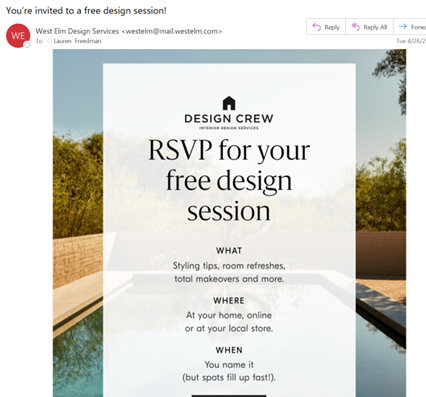
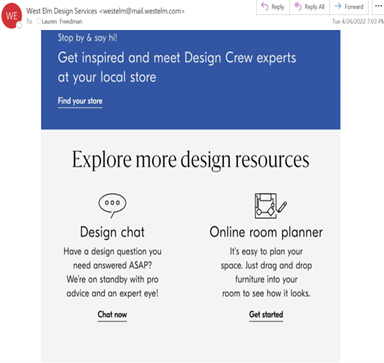
La-Z-Boy encourages shoppers to work with their team of designers. It thoroughly explains the process and attempts to connect prospective buyers with a local designer. When I tried to make an appointment, no one was available in my area. That could be because my nearby store closed. Before and after photos also serve as an enticement for shoppers.
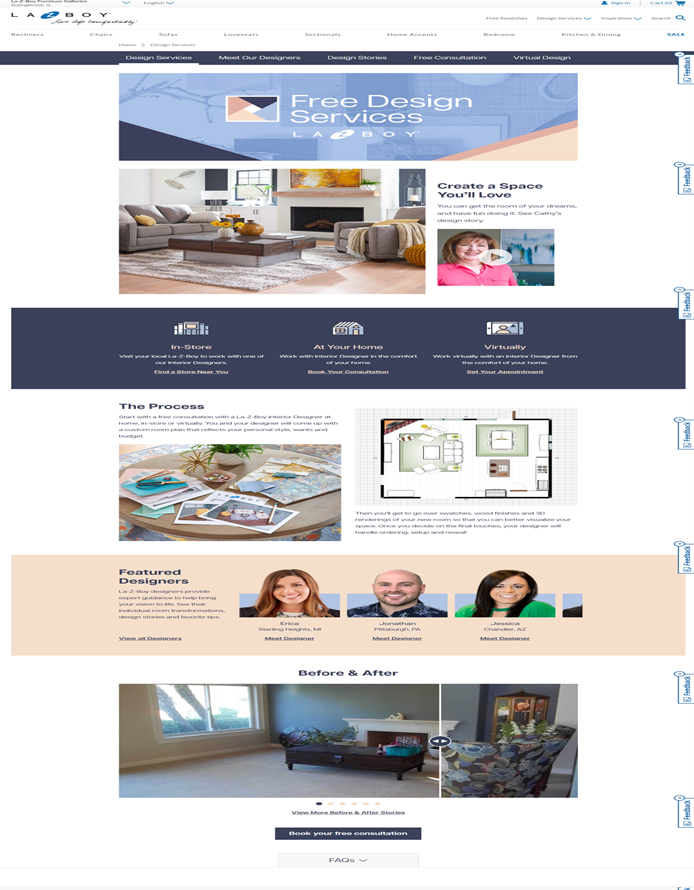
Information gathering
Retailers have become more sophisticated in how they gather information in advance of these calls. For me, Crate & Barrel was the most diligent in its approach. The requests ranged from how you can design the space from a basic room update to starting fresh. Of course, its team needed to know the room, sought color preferences and asked who in the family uses the space. Then came a quick look at a handful of design styles to see which ones best suit the buyer’s style.
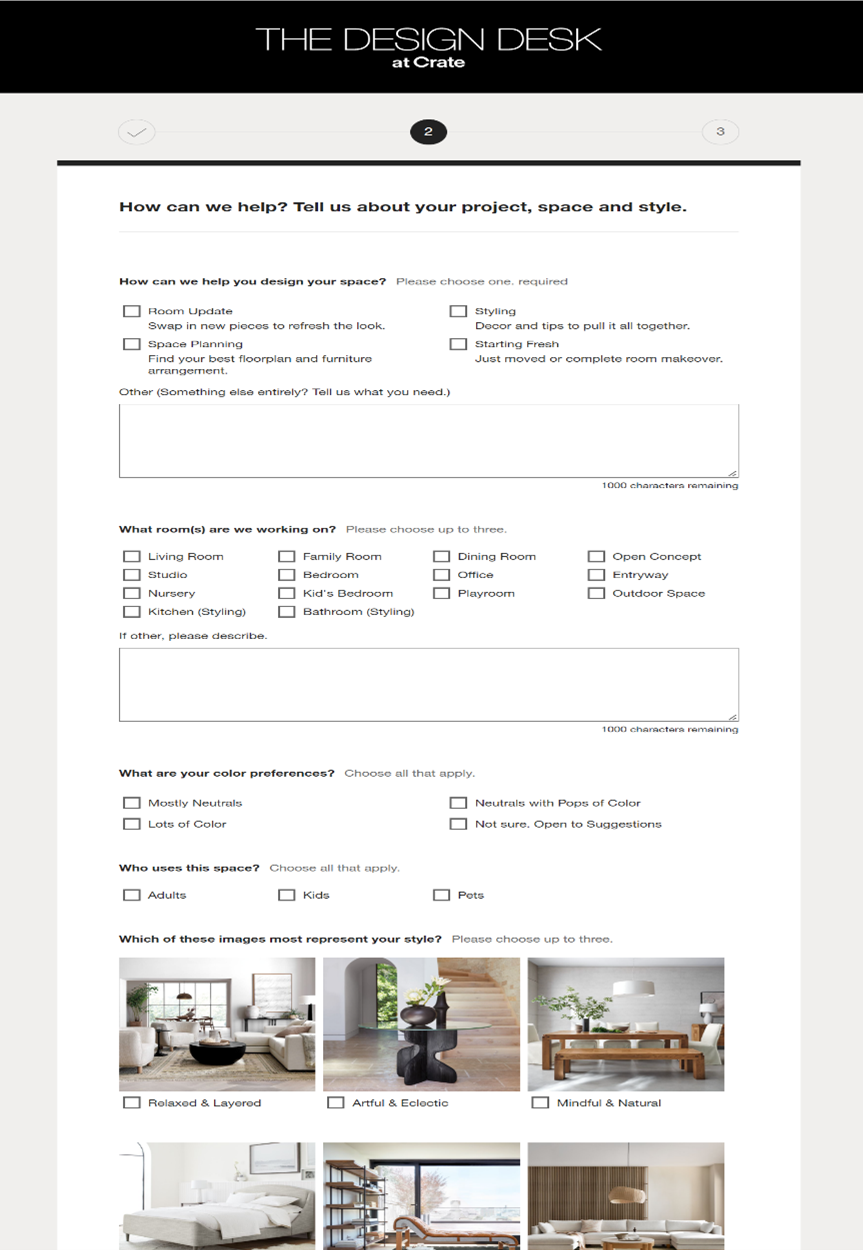
Once that is completed, they smartly ask the customer to do a little homework so the outcome is successful. Customers can upload any inspiration photos and Pinterest boards they want to share. Images of the space are also welcome and, like most who have virtual appointments, an open-ended comment box allows for further input.
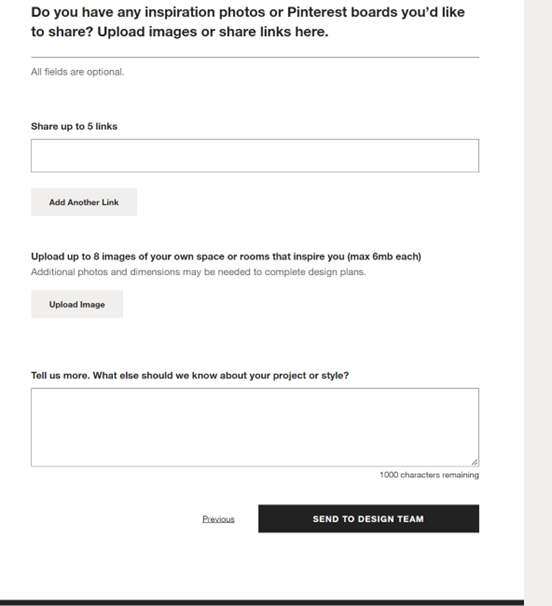
The Experience
Restoration Hardware
In the end, I worked with 3 retailers. Restoration Hardware has a membership model that affords me a 25% discount off purchases made over a one-year time frame. I discussed my initial needs and set up a call with an associate. Another gentleman confirmed, and I let him know I didn’t have a zoom link and still didn’t as the associate called to get started. We ended up using FaceTime. I had previewed some of the collections. She started to ask me about my interests and used Zillow to look at my bedroom, which was helpful. I gave her my style type and pieces and confirmed that I was likely looking at $10K to get the job done.
The associate discussed how they work and the supply chain issues wanting to know my specific delivery needs. She suggested ordering all of the pieces and that they would assemble, though I’d have to handle any pieces from outside Restoration Hardware on my own. She also encouraged coming to the gallery and asked how I would like to receive any follow-up. I said I’d be in touch. And she let me know that prices had increased two-fold during the past year. She touched on how they hold product and said price increases are not applied if orders are open. Her style was warm and helpful, and she would be someone I would seek out. Her follow-up included the two collections we had discussed with prices, delivery and discounts all incorporated. Next stop, lunch at Restoration Hardware and meet the designer.
Pottery Barn
I was asked a series of questions when I returned to the text link confirming the appointment. They included the room, color preferences and my time frame for completing the project. Also requested: inspiration boards and Pottery Barn items of interest. They wanted to know who else would be involved. Again, I didn’t receive a zoom link, but just after 4 p.m., Laura, my designer, reached out for a FaceTime call. She didn’t seem to have the information initially but then was able to access it. The associate said this was already her fourth call of the day. She asked if I was going to show her the room, but I opted not to, indicating that I intended to move.
Most of the time, it felt like I was providing the information and they were mocking it up, which still can be helpful. She walked me through the store, which was a bit dizzying as she noted how parts were constantly rearranged. She did suggest one additional bed that she liked, and I liked it, too. Multiple times throughout the process, she pushed me to visit the store and said she would be happy to meet me. She also was hoping that I would go through the store and her specifically when making any purchase. I welcomed her trend knowledge, and it was nice to know availability for each of the pieces. She said she would follow up but a week later, I hadn’t heard from anyone. To be honest, I don’t even have her contact information to reach out.
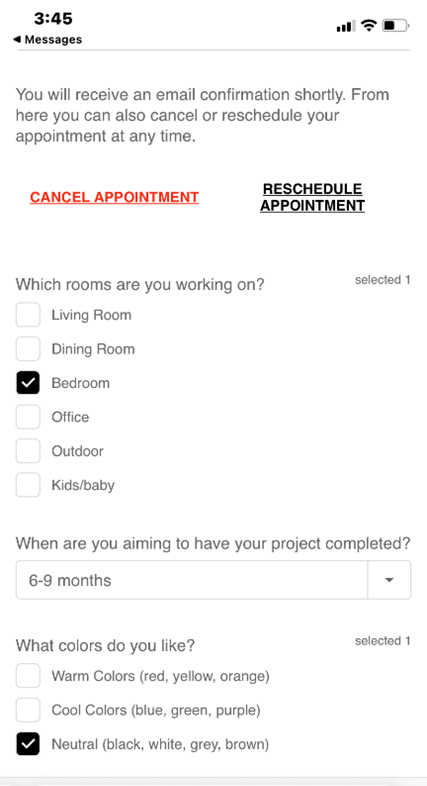
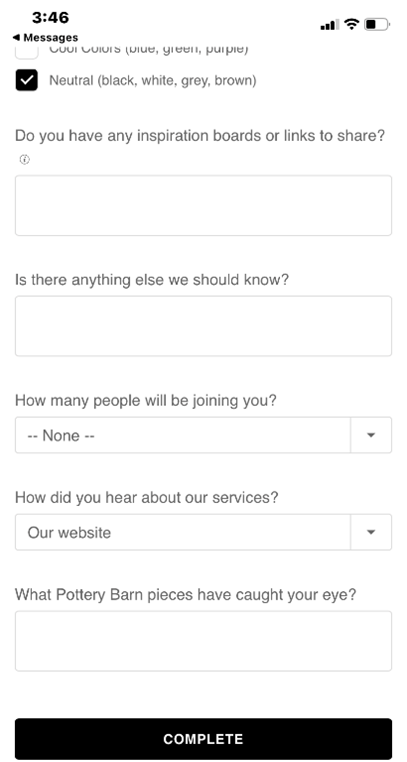
Crate & Barrel
I liked the no-nonsense approach and the fact that the representative, Nick, was all about the design, not about the commission. He had all my details, and an invite for the virtual appointment was in place without any system glitches. Nick asked a series of questions about my vision for the space and shared his capabilities from layouts to 3D renderings. And he inquired about items beyond the standard bed and dresser.
He even wondered if the style should match the home or stand on its own. The representative shared that he preferred a mix-and-match style. It was more fun, and I wouldn’t have any issue coming within budget. He would be able to deliver sketches, mood boards and a shoppable list with notes about the selections within a week. From there, I could make any revisions. He encouraged me to connect with the local store as well. Quick, efficient and everything operating as it should.
My conclusion
Today’s shopper has an endless set of options to take advantage of virtual appointments. They can complete almost any phase of their shopping. While technology can assist in the process, stores need to move beyond their strong marketing efforts. They need to ensure shoppers are ready for their calls. The associates seem to deliver and know their products, but just like the set-up, follow-up is essential in securing the order. I will watch and see, but any lapses on the part of retailers will likely mean shoppers will go elsewhere to solve their home shopping needs.
Stay on top of the latest developments in the ecommerce industry. Sign up for a complimentary subscription to Digital Commerce 360 Retail News.
Follow us on LinkedIn, Twitter and Facebook. Be the first to know when Digital Commerce 360 publishes news content.
Favorite